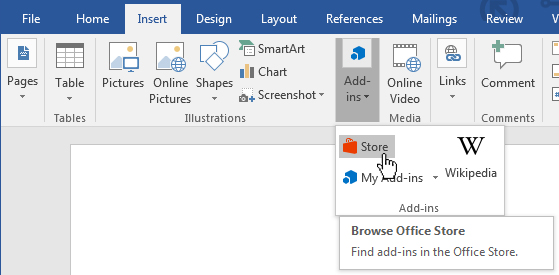
1. Open Word and click Insert -> Add-ins -> Store.

2. In the box that appears, search for RefWorks.
3. Click on RefWorks Citation Manager, then Trust It in the box that pops up.
4. The RefWorks Citation Manager will launch within Word, and a panel will slide out from the right side of your document. Log in using your RefWorks login info.
RefWorks has a built-in reader so there is no need for a .pdf reader or app to read your documents.
Simply select the reference with the document and click the "Read" button in the viewing pane. The full document or article will open for you to read and annotate.

If you do not see a "Read" icon when opening a saved reference in RefWorks, you may need upload the PDF first
You can annotate any of your own documents saved in RefWorks. You may be able to annotate documents shared with you if you have been given permission to annotate and/or modify the document.
To annotate a document:
1. Select the reference with the document and click the "Read" button in the viewing pane. The document will display in the reader.
2. Click the Document Notes icon to make notes OR
3. From the reader menu highlight text and enter your notes.

To add a PDF directly to a reference already in your RefWorks database:
1. Click on the title of the reference that you want to add the PDF to;
2. The reference full view will open on the right side;
3. Click on edit and scroll down;
4. Click on 'add an attachment' OR just drag and drop the file
5. This will open your files stored on your computer. Click on the PDF that you want to import;
6. RefWorks will attach the PDF to the specified reference.
Adding PDF's to your RefWorks database (if you don't have the corresponding reference previously saved RefWorks)
While this is a very handy function, you do need to check the citation. Imported PDFs may have incomplete information, such as missing authors, page numbers, etc.
There are two ways to import a PDF: from a file in your computer, or a recently downloaded file that shows up as an icon at the bottom of your screen.
Importing a PDF from a file (i.e. your "Downloads" folder):

Importing a PDF from a file icon:
